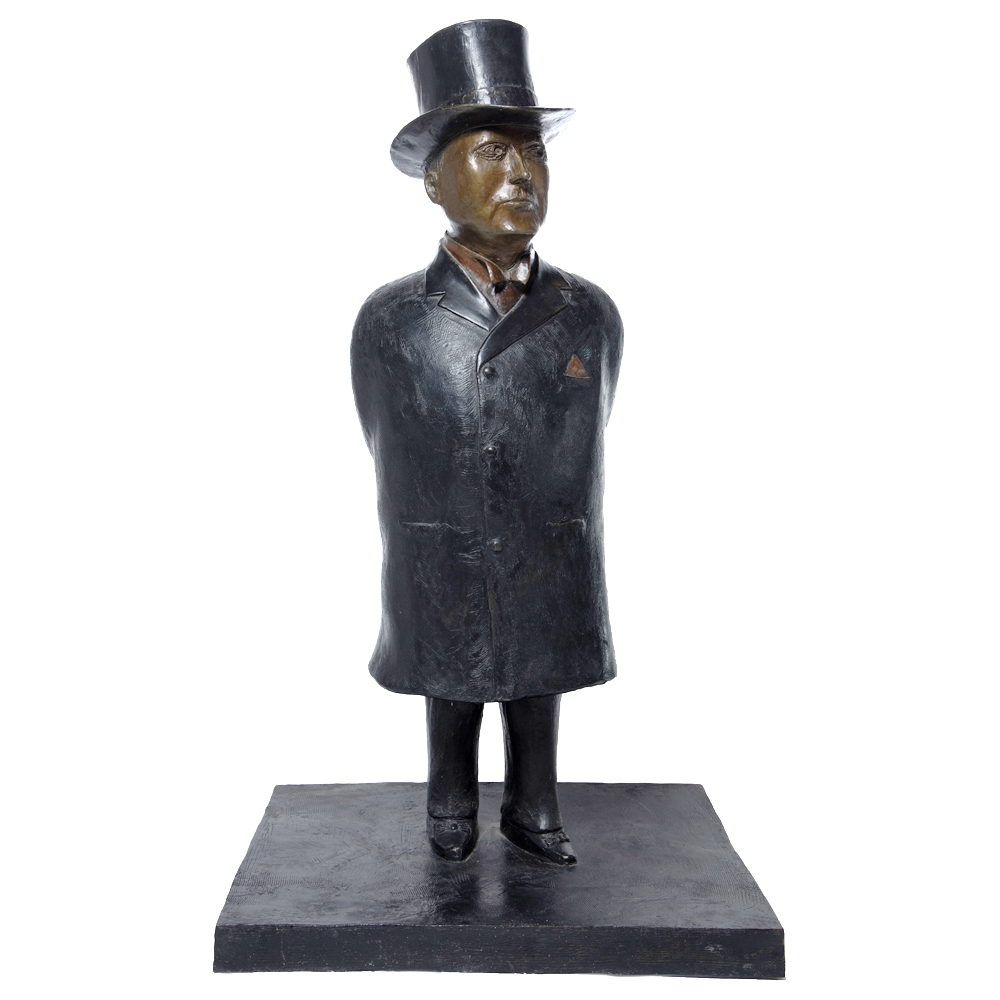McMullen Museum of Art
Permanent Collection
Michael de Lisio (1910–2003)
Henry James, 1969
Bronze cast, edition of 5
McMullen Museum of Art, Boston College, Gift of Sanford Schwartz

Michael de Lisio was an unusual “outsider” artist: he was a self-taught sculptor, in a cosmopolitan city, with a sophisticated aesthetic. In late 1965 de Lisio found himself increasingly disenchanted with his career as a film publicist. That year, while visiting the studio of artist friend Danny Maloney, he was strongly encouraged to “make something.”1 At the age of fifty-five, de Lisio sculpted his first head, a Modigliani-esque self-portrait in wax. Always an avid reader, he was also a poet who was published in the New Yorker, where he got “poetry lessons”2 in the form of useful criticism from editor E. B. White. The writers he most admired became his subject matter, unifying his love of literature with his new interest in sculpture. Heads became portraits, the first a semi-abstract relief of Marcel Proust. As clay replaced wax, “I got myself a studio, because I was serious,”3 which motivated him to cast the terracotta figures in bronze, which were then colored with various patinas.
Without ever having taken lessons, he reinvented technique as he needed, developing an individual style which appears in a series of busts which includes Edgar Allen Poe, Marianne Moore, Gertrude Stein, Vladimir Nabokov, W. H. Auden, and Aubrey Beardsley, and his standing figures of Robert Louis Stevenson and Ezra Pound—all completed within two years. Developing a semi-naturalistic but individualized sense of form, the figures are intimate and oddly monumental, having an unusual sense of scale for sculptures so small in size.
A great fan of snapshots, de Lisio worked largely from photographs gathered from books, magazines, and newspapers. He intended to capture both the lives and what he terms “the poetry in the work” of the writers (and later the artists) that he sculpted—an ambitious project for a self-described “primitive”4 in technique. Following his “private need”5 to express form and technical naivete, he has sidestepped the weight of history and artistic tradition, moving his work beyond caricature.
In the two decades when the dominant art movements were conceptual or minimal, large scale, and abstract, de Lisio was an anomaly. He made sculpture that was unschooled, figurative, and small-scale about a personal pantheon of artists and writers that shaped the century, and he is all the more unique for it.
1. Alston Conley, interview with Michael de Lisio (unpublished typescript, February 1998).
2. Martha Saxton, “The Biographer,” Connoisseur 215 (September 1985): 140–48.
3. Conley, interview with de Lisio.
4. Michael de Lisio, Michael di Liseo [sic]: Sculptures (New York: Zabriskie Gallery, 1986).
5. Sanford Schwartz, Michael de Lisio (New York: Brooke Alexander Inc., 1978).
6 Schwartz, de Lisio.

John McCoy
Assistant Director, McMullen Museum
One of the most respected writers in American letters, Henry James (1843–1916) is today remembered as an author whose work bridged the literary schools of realism, which sought to depict its subjects an unvarnished and unsentimental fashion, and modernism, which self-consciously experimented with form and often focused on interior experience. In works such as his novel The Portrait of a Lady (1881) or his novella The Turn of the Screw (1898), James explored character through portrayals of consciousness and motivation. In this way, he shared interests with his philosopher brother, William James (1843–1910), whose work focused on psychology and meaning.
In their young adult years, both of the James brothers received art instruction from William Morris Hunt (1824–79), whose Woman Knitting and Cow (Fontainebleau), 1860, is on display in the first floor Sitar Family Conference Room. Through Hunt they met and befriended the artist John La Farge (1835–1910). William James was the model for La Farge’s St. John the Evangelist at the Foot of the Cross, 1862–63, on display in the Casimir-Lambert Conference Room.
Here de Lisio sculpts James in a frock coat: a knee-length jacket with reverse lapels that were sewn on. Frock coats were fashionable through most of the 19th century, but the side pockets and the pocket square that are depicted in this sculpture were a late-Victorian addition. The wing-tipped shirt collar and the top hat complete this presentation of James as a moneyed, somewhat stuffy, man-about-town.

Alston Conley
Associate Professor of the Practice, Studio Art, and Curator, McMullen Museum of Art (retired)